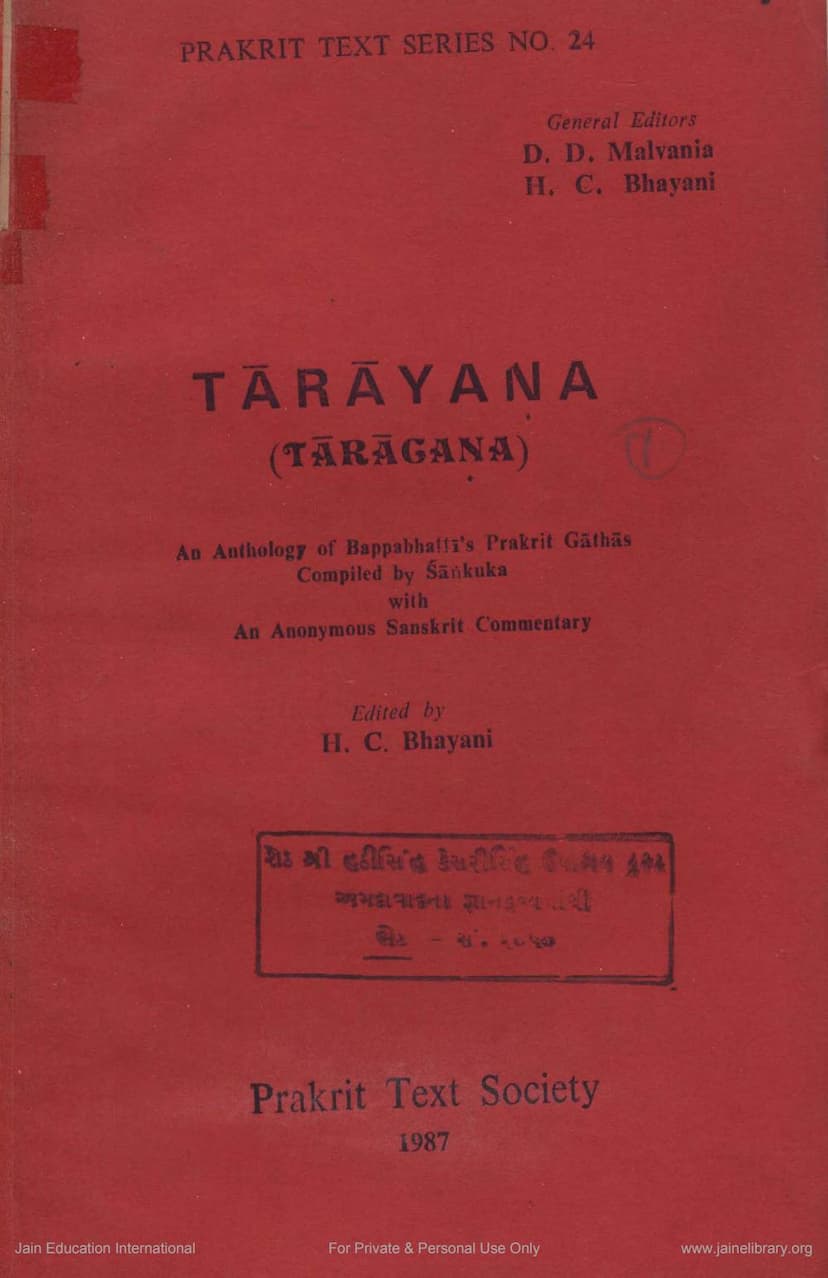Tarayana
Added to library: September 2, 2025

Summary
Here's a comprehensive summary of the Jain text "Tarāyana" based on the provided pages:
Book Title: Tārāyana (also transliterated as Tārāgaṇa) Author(s): Compiled by Sankuka, featuring Prakrit Gāthās by Bappabhaṭṭi-sūri. Includes an anonymous Sanskrit Commentary. Publisher: Prakrit Text Society, Ahmedabad Publication Year: 1987 Series: Prakrit Text Series No. 24
Core Content and Significance:
"Tārāyana" is a significant anthology of Prakrit muktaka verses (short, independent poems) attributed to the renowned Jain monk and poet Bappabhaṭṭi-sūri. The work is meticulously compiled by Sankuka, who also provides introductory and index verses. A notable feature is the inclusion of an anonymous Sanskrit commentary, which is crucial for understanding the nuances and meanings of the verses.
Key Aspects and Contributions:
-
Preservation of Prakrit Muktaka Poetry: The primary importance of Tārāyana lies in its being the sole preserved specimen of Prakrit muktaka poetry from a known author who flourished in the period between the famous Hala Sātavāhana (author of the Gāthāsaptashati) and Jayavallabha (author of the Vajjālagga). This fills a crucial gap in the history of Prakrit literature.
-
Compilation by Sankuka: Sankuka, a contemporary of Bappabhaṭṭi-sūri and a member of the literary elite at the court of King Nāgāvaloka (Amma), compiled this anthology. His contribution includes:
- Collecting and Arranging Verses: Sankuka gathered Bappabhaṭṭi's scattered gāthās.
- Index Verses: Each group of Bappabhaṭṭi's verses is preceded by an "index verse" from Sankuka, which lists keywords from the subsequent verses, serving as a mnemonic device and indicating the theme.
- Literary Skill: Sankuka himself is revealed as a skilled Prakrit poet, capable of composing verses of high literary excellence.
-
Bappabhaṭṭi-sūri's Poetry: The anthology showcases Bappabhaṭṭi-sūri's poetic prowess. The verses cover a wide range of topics, including:
- Mangala (Auspicious Invocation): Verses of auspicious beginnings.
- Poet Praise (Kavi-praśansā): Glorification of poets.
- Good and Wicked People (Sajjana-durjana): Contrasting the virtuous and the unvirtuous.
- Nature: Descriptions of rain (lightning, clouds, sky), the lamp.
- Love and Romance (Anurāga, Viraha): Themes of love, longing, and separation, often depicted with sophisticated literary devices.
- Praise of Patron-King (Rāja-cāṭu): Verses flattering the king.
- Miscellaneous Topics: Including breasts, lotus plants, unchaste women, etc.
- Literary Merit: Bappabhaṭṭi's verses are noted for their ornate style, effective use of śleṣa (puns and double meanings), and skillful employment of various figures of speech. His imagery often draws from everyday life, making the verses vivid and impactful.
-
Sanskrit Commentary: The anonymous Sanskrit commentary is invaluable for its detailed explanations of the Prakrit verses. It clarifies difficult words, explains compound expressions, resolves ambiguities, identifies figures of speech, and elucidates the overall purport of the verses. The commentator, identified as a Jain, demonstrates admirable knowledge of both Prakrit and Sanskrit. The commentary itself is estimated to be from the 10th century, making it a contemporary or near-contemporary explanation of the text.
-
The "Listing Device": The use of index verses by Sankuka is a significant literary device. This practice, where a verse lists keywords of subsequent verses, is found in other Jain traditions (like dvāra-gāthās in Niryuktis) and serves mnemonic, organizational, and authorship-preservation purposes. Tārāyana provides early and substantial evidence of this technique applied to muktaka collections.
-
Historical Context and Bappabhaṭṭi-sūri's Life: The introduction provides a detailed account of Bappabhaṭṭi-sūri's life, drawing from traditional Jain sources like the Bappabhaṭṭi-kathānaka and Prabhāvakacarita. Key points include his association with King Āma (Nāgābhatta II of the Gurjara-Pratihāra dynasty), his scholarship, and his reputation as a poet. The discovery of Tārāyana is seen as corroborating the traditional accounts of Bappabhaṭṭi's poetic abilities and associations. The traditional dates for his life are roughly 800-895 A.D.
-
Manuscript: The edition is based on the only known manuscript, which is incomplete, with some folios missing, leading to a gap in the text (verses 100-126 and their commentary). The manuscript itself is dated to "not later than 1500 A.D."
Overall Contribution:
"Tārāyana" is a vital text for understanding the development of Prakrit poetry, particularly the muktaka genre. It highlights the literary achievements of Bappabhaṭṭi-sūri, a prominent Jain poet, and showcases the meticulous work of Sankuka in compiling and preserving his poetry. The presence of the Sanskrit commentary further enhances its scholarly value, offering deep insights into the linguistic and literary aspects of the work. The anthology provides a rich tapestry of classical Indian poetic themes, expressed with skill and elegance in Prakrit.